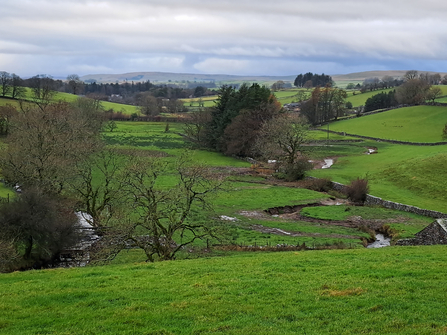
Scandal Beck and new channel at Bowber Head Farm Nature Reserve © Eden Rivers Trust

Scandal Beck and new channel at Bowber Head Farm Nature Reserve © Eden Rivers Trust
Eden Rivers Trust (ERT), in partnership with the Environment Agency, Cumbria Wildlife Trust, Natural England and the Westmorland Dales Landscape Partnership has put the wiggles back into a historically straightened drain and reconnected it with three hectares of floodplain. They have also created four scrapes that will act as natural flood management, holding more water on the land during heavy rain then slowly releasing it into the river over time.
These features have created valuable habitat in the river and the meadow that will boost wildlife numbers and species and reduce potential flood risk to communities downstream.
Andrew Walter, Reserves Officer at Cumbria Wildlife Trust explains why the river needs to be re-wiggled:
“Straightened rivers reduce habitat quality and the water moves through more quickly - in some cases increasing the flood risk downstream. By putting the ‘wiggles’ back in, we’ll restore this river to a more natural river habitat, with the bends acting like brakes to reduce the flood risk. They also will allow more space and time for the water to move. A natural river like this with rejuvenated riverbanks will provide a sanctuary for wildlife … and people.
“Bowber Head Farm is renowned for its amazing northern hay meadows, which we’ve been restoring since 2020. Once the river is re-wiggled, water will spill over onto some of the surrounding hay meadows during periods of high rainfall, enhancing these valuable meadows, and then trickle back in again as the water level drops.”
ERT’s years of experience in taking heavily modified, straightened rivers and rejuvenating them with naturally occurring features such as meanders, pools and riffles was put to the test here with both Scandal Beck and a heavily modified, straightened drain (running parallel to the beck) flowing through the middle of the Bowber Head and Piper Hole Meadows SSSI (Site of Special Scientific Interest).
This nationally important, northern upland hay meadow is home to 92 plant species, such as wood crane’s-bill, greater burnet and lady’s mantles. These wet/marsh loving plants should all thrive because of this project; however great care would be needed to ensure that any impact on the hay meadow from the works was minimised.
Lev Dahl, River Restoration Manager at Eden Rivers Trust explained how they ensured that the SSSI was protected during the project:
“From start to finish our aim has been to minimise the impact on the SSSI hay meadow. Before work started, our volunteers undertook fish rescues to ensure protected species such as bullhead and white-clawed crayfish could be safely relocated to Scandal Beck and we used various methods, including hay bales to reduce the levels of sediment travelling downstream throughout the works.
“Our contractors, Catchment Designs ensured that movement of heavy machinery over the site was carefully controlled and minimised. Diggers were powered by biofuels and only followed the path of the new channel - digging it so that earth didn’t end up on the field. Work stopped during heavy rain/wet conditions so that the earth wasn’t churned up.”
Re-using materials from within the site was essential to preserve its special nature. The turf used was from the site and contains species-rich, native seeds sourced from the adjacent wildflower meadows, and material dug out from the new scrapes was used to fill in the old, straightened channel and create a kest (raised mound for a hedge).”
This winter, volunteers will help plant a 400m hedgerow on the kest to further reduce the amount of runoff and excess water reaching the river, reducing peak river levels during heavy rain and improving water quality.
This work was made possible thanks to generous support and funding from the Environment Agency and the Westmorland Dales Landscape Partnership Scheme which is supported by a grant from the National Lottery Heritage Fund.
David Evans, Westmorland Dales Landscape Partnership Scheme Manager said: “It’s fantastic to see this project being delivered towards the end of the Scheme despite some of the challenges faced. A great example of partnership working and something which has already made a big impact. I look forward to seeing how it looks next summer.”